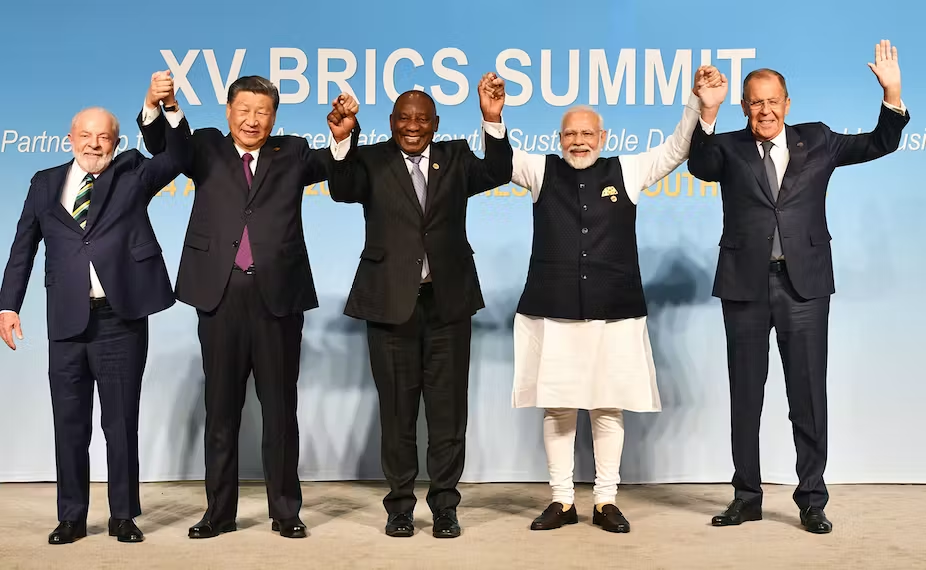
BRICS: Will greater strength increase relevance?
text_fieldsThe BRICS summit in Johannesburg, South Africa, concluded last Thursday with a somewhat dramatic announcement. It was announced that in addition to the current member countries such as Brazil, Russia, India, China and South Africa, six countries, i.e. Saudi Arabia, United Arab Emirates (UAE), Egypt, Iran, Ethiopia and Argentina will also be added as members from next January. The decision to increase the number of members by more than double and the new members outnumbering the existing ones is unusual in the history of a coalition of nations. Formed in 2009, BRICS became a five-nation alliance with the addition of South Africa in 2010. About 40 countries have shown interest in joining the alliance and at least 22 countries have formally expressed it in writing. When the new members are added, BRICS will account for 40 per cent of the world's population and 30 per cent of the world's GDP. The rich and developed nations which constitute the G7 alliance, account for only 10 percent of the population, but their total GDP share is almost the same as that of the BRICS. In this context, a factor that increases the significance of BRICS is that four of the world's leading oil-producing countries are members of the alliance, and thus about 40 percent of global oil production will come from the BRICS countries.
The main objectives of the relatively loosely structured BRICS are to accelerate trade cooperation, development and mutual fostering of the economy of member countries. Be that as it may, BRICSright from inception has given the impression of being a counter voice to the U.S.-Europe-led G7 alliance, globally. Certain stances adopted recently may also vouch for that. These include responses to resolutions on climate change, structural reforms of the United Nations, and non-cooperation regarding the sanctions imposed by the West against Iran, Russia and Venezuela. However, there was no unanimity among the member countries on all global issues. In the turbulent issue of the Ukraine war, India, China and South Africa abstained from the UN resolutions against Russia. But none of the remaining countries supported Russia’s stance either. It is also true that border disputes between India and China have cast a shadow on the whole-hearted unity at the alliance level. That said, BRICS has also gained importance as a platform for Russia and China to lie on the support from other countries on several issues. Except for the fact that there are some similarities in certain stances, BRICS does not yet have a history of tackling any coalition through assertive approaches or military options like NATO. However, in the economic sphere, the New Development Bank (NDB) formed by BRICS, has already by now 33 billion dollars in loans for development and hence, it can be said that it is trying to be an alternative to the financial institutions such as the World Bank and the IMF, heavily dominated by Western powers.
 Also Read: Six new countries to join BRICS bloc
Also Read: Six new countries to join BRICS bloc
Although there was a consensus in BRICS that mutual payments should be in regional currency instead of dollars, two-thirds of the loans for hundreds of projects worth 33 billion dollars issued by the NDB, were denominated in dollars. This speaks for the limitations of BRICS. However, this situation may change for the better with the entry of oil-rich countries which can help make more money available. Moreover, in the context of sanctions on Russia, the energy transactions between India and Russia in the Rupee-Rouble payment scheme will help in experimenting with the new model of dollar-free transaction in international trade. However, the BRICS member states have been voting in different ways on many issues on the UN platform. China's hegemony to replace the United States in the global balance of power and thereby to gain more dominance in the global economy may hinder effective unanimity.
The main driver behind the interest of around 40 countries to join the alliance, and also for the current BRIC countries to expand the membership base, is probably the common sentiment about the need to end the U.S. dominance on critical issues. The belief that it will help gain more visibility and recognition for their positions might have also influenced the decision. In that case, in addition to the six countries, more members are likely to be added. It is natural for those countries to infer that the participation of more countries which adds clout and meaning to the alliance, can create more impact than a small group sitting around a small round table and flexing muscles. To sum up, two factors may have weighed in on the new membership applicants and the BRICS countries. One is the shared sentiment against U.S. dominance. Second, the aspiration for global equality with a cluster of developing countries reflecting the sentiments of southern hemisphere countries. To accomplish both, national leaderships will have to become more purposeful and also display a democratic model that is acceptable domestically. India, which is at the forefront of the BRICS countries in terms of population as well as the size of its economy, can play a leadership role in this. However, for making a claim to that role, the country's internal shortfalls must be sorted out first.
 Also Read: PM Modi travels to South Africa for BRICS Leaders' Retreat
Also Read: PM Modi travels to South Africa for BRICS Leaders' Retreat
























